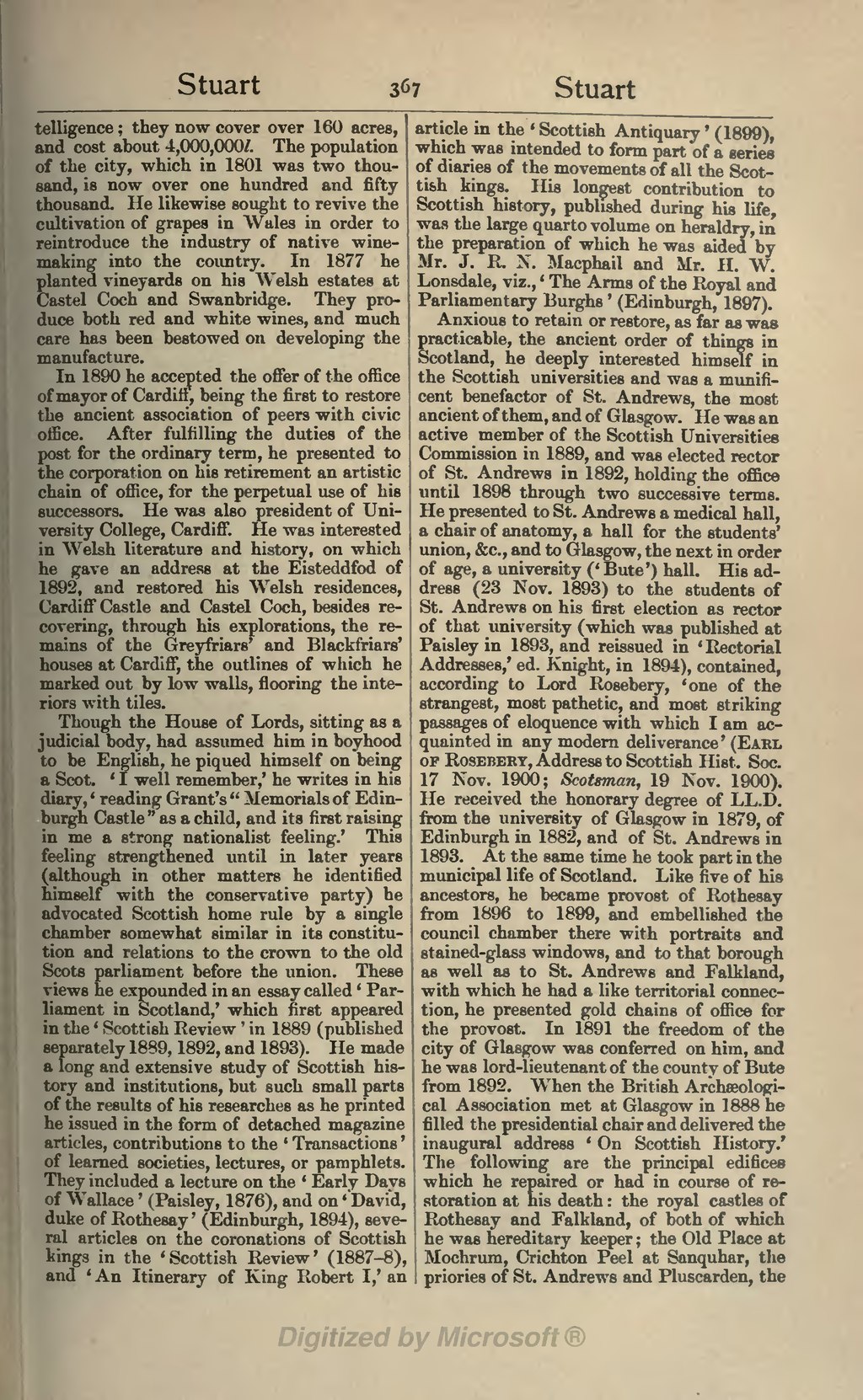telligence; they now cover over 160 acres, and cost about 4,000,000l. The population of the city, which in 1801 was two thousand, is now over one hundred and fifty thousand. He likewise sought to revive the cultivation of grapes in Wales in order to reintroduce the industry of native wine-making into the country. In 1877 he planted vineyards on his Welsh estates at Castel Coch and Swanbridge. They produce both red and white wines, and much care has been bestowed on developing the manufacture.
In 1890 he accepted the offer of the office of mayor of Cardiff, being the first to restore the ancient association of peers with civic office. After fulfilling the duties of the post for the ordinary term, he presented to the corporation on his retirement an artistic chain of office, for the perpetual use of his successors. He was also president of University College, Cardiff. He was interested in Welsh literature and history, on which he gave an address at the Eisteddfod of 1892, and restored his Welsh residences, Cardiff Castle and Castel Coch, besides recovering, through his explorations, the remains of the Greyfriars' and Blackfriars' houses at Cardiff, the outlines of which he marked out by low walls, flooring the interiors with tiles.
Though the House of Lords, sitting as a judicial body, had assumed him in boyhood to be English, he piqued himself on being a Scot. 'I well remember,' he writes in his diary, 'reading Grant's "Memorials of Edinburgh Castle" as a child, and its first raising in me a strong nationalist feeling.' This feeling strengthened until in later years (although in other matters he identified himself with the conservative party) he advocated Scottish home rule by a single chamber somewhat similar in its constitution and relations to the crown to the old Scots parliament before the union. These views he expounded in an essay called 'Parliament in Scotland,' which first appeared in the 'Scottish Review' in 1889 (published separately 1889, 1892, and 1893). He made a long and extensive study of Scottish history and institutions, but such small parts of the results of his researches as he printed he issued in the form of detached magazine articles, contributions to the 'Transactions' of learned societies, lectures, or pamphlets. They included a lecture on the 'Early Days of Wallace' (Paisley, 1876), and on 'David, duke of Rothesay' (Edinburgh, 1894), several articles on the coronations of Scottish kings in the 'Scottish Review' (1887-8), and 'An Itinerary of King Robert I,' an article in the 'Scottish Antiquary' (1899), which was intended to form part of a series of diaries of the movements of all the Scottish kings. His longest contribution to Scottish history, published during his life, was the large quarto volume on heraldry, in the preparation of which he was aided by Mr. J. R. X. Macphail and Mr. H. W. Lonsdale, viz., 'The Arms of the Royal and Parliamentary Burghs' (Edinburgh, 1897).
Anxious to retain or restore, as far as was practicable, the ancient order of things in Scotland, he deeply interested himself in the Scottish universities and was a munificent benefactor of St. Andrews, the most ancient of them, and of Glasgow. He was an active member of the Scottish Universities Commission in 1889, and was elected rector of St. Andrews in 1892, holding the office until 1898 through two successive terms. He presented to St. Andrews a medical hall, a chair of anatomy, a hall for the students' union, &c., and to Glasgow, the next in order of age, a university ('Bute') hall. His address (23 Nov. 1893) to the students of St. Andrews on his first election as rector of that university (which was published at Paisley in 1893, and reissued in 'Rectorial Addresses,' ed. Knight, in 1894), contained, according to Lord Rosebery, 'one of the strangest, most pathetic, and most striking passages of eloquence with which I am acquainted in any modern deliverance' (Earl of Roseberry, Address to Scottish Hist. Soc. 17 Nov. 1900; Scotsman, 19 Nov. 1900). He received the honorary degree of LL.D. from the university of Glasgow in 1879, of Edinburgh in 1882, and of St. Andrews in 1893. At the same time he took part in the municipal life of Scotland. Like five of his ancestors, he became provost of Rothesay from 1896 to 1899, and embellished the council chamber there with portraits and stained-glass windows, and to that borough as well as to St. Andrews and Falkland, with which he had a like territorial connection, he presented gold chains of office for the provost. In 1891 the freedom of the city of Glasgow was conferred on him, and he was lord-lieutenant of the county of Bute from 1892. When the British Archæological Association met at Glasgow in 1888 he filled the presidential chair and delivered the inaugural address 'On Scottish History.' The following are the principal edifices which he repaired or had in course of restoration at his death: the royal castles of Rothesay and Falkland, of both of which he was hereditary keeper; the Old Place at Mochrum, Crichton Peel at Sanquhar, the priories of St. Andrews and Pluscarden, the
